Comparative Experimental Study of Sustainable Reinforced Portland Cement Concrete and Geopolymer Concrete Beams Using Rice Husk Ash
Abstract
:1. Introduction
2. Materials and Methods
2.1. Materials
2.2. Mix Proportions and Specimen Preparation
2.3. RC Beam Specimens and Testing
3. Results and Discussion
3.1. Compressive Strength and Optimum Mix Proportion
3.2. Structural Behavior of RC Beam under Flexure
3.2.1. Load–Deflection Curves and Crack Pattern
3.2.2. Failure Mode
3.2.3. Effects on Beam Ductility
3.2.4. Comparison between Experimental Result and Design Code
4. Conclusions
- In comparison to the control PC (0% RHA), when a higher proportion of RHA replacement is used in the concrete, the compressive strength of the PC-RHA and GC-RHA is decreased;
- The compressive strength of the GC-RHA mixture shows a high compressive strength at 7 and 14 days of testing, when compared to the result obtained at 28 days. This corresponding compressive strength accounts for approximately 75% and 90% of the 28-day compressive strength, respectively. Therefore, considering the high compressive strength, this type of concrete is appropriate for use in applications such as precast concrete members;
- The curves of the PC-RHA beam and GC-RHA beam are bilinear until the first crack load and before the yield load. Then, they become nonlinear after the yield load of the beam specimens. Similar load–deflection curves were seen in all beam types in these test results;
- The GC-RHA beam has a smaller maximum crack width than the PC-RHA beam. The average maximum crack width of the GC-RHA beam was 3.1 mm or 82% and 84% of the PCC and PC-RHA beam, respectively. Additionally, the GC-RHA beam is more ductile than the PC-RHA beams. As a result, the GC-RHA beam with ambient temperature curing can be regarded as a reasonable alternative compared to the PC-RHA beam;
- The ACI equation delivers accurate predictions with a 4 to 7% margin of error. This shows that the experimental load capabilities of the PC-RHA beam and GC-RHA beam agree well with the ACI design equation;
- Lastly, because the overall flexural behaviors of PC-RHA and GC-RHA beams are similar to those of conventional PCC beams in terms of load–deflection, cracking propagation, and failure mechanism, designers generally accepted that PC-RHA and GC-RHA beams could be designed in the same way.
Author Contributions
Funding
Acknowledgments
Conflicts of Interest
References
- Kim, S.; Lee, D.-E.; Kim, Y.; Kim, S. Development and application of precast concrete double wall system to improve productivity of retaining wall construction. Sustainability 2020, 12, 3454. [Google Scholar] [CrossRef] [Green Version]
- Chen, Y.; Okudan, G.E.; Riley, D.R. Sustainable performance criteria for construction method selection in concrete buildings. Autom. Constr. 2010, 19, 235–244. [Google Scholar] [CrossRef]
- Qin, Y.; Shu, G.P.; Zhou, G.G.; Han, J.H. Compressive behavior of double skin composite wall with different plate thicknesses. J. Constr. Steel Res. 2019, 157, 297–313. [Google Scholar] [CrossRef]
- Yang, Z.; Ma, Z.; Wu, S. Optimized flowshop scheduling of multiple production lines for precast production. Autom. Constr. 2016, 72, 321–329. [Google Scholar] [CrossRef] [Green Version]
- Zhai, X.; Reed, R.; Mills, A. Factors impeding the offsite production of housing construction in China: An investigation of current practice. Constr. Manag. Econ. 2014, 32, 40–52. [Google Scholar] [CrossRef]
- Ahmad, S.; Soetanto, R.; Goodier, C. Lean approach in precast concrete component production. Built Environ. Proj. Asset Manag. 2019, 9, 457–470. [Google Scholar] [CrossRef] [Green Version]
- Singhal, S.; Chourasia, A.; Kajale, Y. Cyclic behaviour of precast reinforced concrete beam-columns connected with headed bars. J. Build. Eng. 2021, 42, 103078. [Google Scholar] [CrossRef]
- Farzampour, A. Temperature and humidity effects on behavior of grouts. Adv. Concr. Constr. 2017, 5, 659–669. [Google Scholar]
- Farzampour, A. Compressive behavior of concrete under environmental effects. In Compressive Strength of Concrete; Pavlo, K., Ed.; IntechOpen: London, UK, 2019. [Google Scholar]
- Mansouri, I.; Shahheidari, F.S.; Mohammad Ali Hashemi, S.; Farzampour, A. Investigation of steel fiber effects on concrete abrasion resistance. Adv. Concr. Constr. 2020, 9, 367–374. [Google Scholar]
- Chalangaran, N.; Farzampour, A.; Paslar, N. Nano silica and metakaolin effects on the behavior of concrete containing rubber crumbs. CivilEng 2020, 1, 264–274. [Google Scholar] [CrossRef]
- Chalangaran, N.; Farzampour, A.; Paslar, N.; Fatemi, H. Experimental investigation of sound transmission loss in concrete containing recycled rubber crumbs. Adv. Concr. Constr. 2021, 11, 447–454. [Google Scholar]
- Hong, W.K.; Kim, J.M.; Park, S.C.; Kim, S.I.; Lee, S.G.; Lee, H.C.; Yoon, K.J. Composite beam composed of steel and pre-cast concrete. (Modularized Hybrid System, MHS) Part II: Analytical investigation. Struct. Des. Tall Build. 2009, 18, 891–905. [Google Scholar] [CrossRef]
- Hong, W.K.; Park, S.C.; Kim, J.M.; Lee, S.G.; Kim, S.I.; Yoon, K.J.; Lee, H.C. Composite beam composed of steel and precast concrete (Modularized Hybrid System, MHS). Part I: Experimental investigation. Struct. Des. Tall Build. 2010, 19, 275–289. [Google Scholar] [CrossRef]
- Hong, J.; Shen, G.Q.; Li, Z.; Zhang, B.; Zhang, W. Barriers to promoting prefabricated construction in China: A cost-benefit analysis. J. Clean. Prod. 2017, 172, 649–660. [Google Scholar] [CrossRef]
- Chindaprasirt, P.; Rattanasak, U.; Taebuanhuad, S. Resistance to acid and sulfate solutions of microwave-assisted high calcium fly ash geopolymer. Mater. Struct. 2013, 46, 375–381. [Google Scholar] [CrossRef]
- Velazquez, S.; Monzo, J.M.; Borrachero, M.V.; Paya, J. Assessment of pozzolanic activity using methods based on the measurement of electrical conductivity of suspensions of Portland cement and pozzolan. Materials 2014, 7, 7533–7547. [Google Scholar] [CrossRef] [Green Version]
- Phoo-ngernkham, T.; Hanjitsuwan, S.; Detphan, S.; Thumrongvut, J.; Suksiripattanapong, C.; Damrongwiriyanupap, N.; Chindaprasirt, P.; Hatanaka, S. Shear bond strength of FA-PC geopolymer under different sand to binder ratio and sodium hydroxide concentration. Int. J. Geomate 2018, 14, 52–57. [Google Scholar] [CrossRef]
- Bokkhunthod, N.; Thumrongvut, J.; Supromwan, J.; Seangatith, S. Experimental study of cellular lightweight concrete-filled steel tube columns using hydraulic cement. Key Eng. Mater. 2022, 922, 147–152. [Google Scholar] [CrossRef]
- Suksiripattanapong, C.; Phetprapai, T.; Singsang, W.; Phetchuay, C.; Thumrongvut, J.; Tabyang, W. Utilization of recycled plastic waste in fiber reinforced concrete for eco-friendly footpath and pavement applications. Sustainability 2022, 14, 6839. [Google Scholar] [CrossRef]
- Suksiripattanapong, C.; Krosoongnern, K.; Thumrongvut, J.; Sukontasukkul, P.; Horpibulsuk, S.; Chindaprasirt, P. Properties of cellular lightweight high calcium bottom ash-portland cement geopolymer mortar. Case Stud. Constr. Mater. 2020, 12, e00337. [Google Scholar] [CrossRef]
- Bahurudeen, A.; Deepak, K.; Gokul Dev, V.; Santhanam, M. Performance evaluation of sugarcane bagasse ash blended cement in concrete. Cem. Concr. Compos. 2015, 59, 77–88. [Google Scholar] [CrossRef]
- Cordeiro, G.C.; Tavares, L.M.; Toledo Filho, R.D. Improved pozzolanic activity of sugar cane bagasse ash by selective grinding and classification. Cem. Concr. Res. 2016, 89, 269–275. [Google Scholar] [CrossRef]
- Jongphimai, D.; Cherdsak Suksiripattanapong, C.; Thumrongvut, J. Effect of Na2SiO3/NaOH ratio on compressive strength of lateritic soil mixed with bagasse ash geopolymer. IOP Conf. Ser. Mater. Sci. Eng. 2019, 600, 012015. [Google Scholar] [CrossRef] [Green Version]
- Chindaprasirt, P.; Kroehong, W.; Damrongwiriyanupap, N.; Suriyo, W.; Jaturapitakkul, C. Mechanical properties, chloride resistance and microstructure of Portland fly ash cement concrete containing high volume bagasse ash. J. Build. Eng. 2020, 31, 101415. [Google Scholar] [CrossRef]
- Torres, S.M.; de Lima, V.E.; de Azevedo Basto, P.; de Araujo, N.T., Jr.; de Melo Neto, A.A. Assessing the pozzolanic activity of sugarcane bagasse ash using X-ray diffraction. Constr. Build. Mater. 2020, 264, 120684. [Google Scholar] [CrossRef]
- Azad, N.M.; Samarakoon, S.M.S.M.K. Utilization of industrial by-products/waste to manufacture geopolymer cement/concrete. Sustainability 2021, 13, 873. [Google Scholar] [CrossRef]
- Da Silva, S.R.; Andrade, J.J.D.O. A review on the effect of mechanical properties and durability of concrete with construction and demolition waste (CDW) and fly ash in the production of new cement concrete. Sustainability 2022, 14, 6740. [Google Scholar] [CrossRef]
- Phoo-ngernkham, T.; Hanjitsuwan, S.; Suksiripattanapong, C.; Thumrongvut, J.; Suebsuk, S.; Sookasem, S. Flexural strength of notched concrete beam filled with alkali-activated binders under different types of alkali solutions. Constr. Build. Mater. 2016, 127, 673–678. [Google Scholar] [CrossRef]
- Singh, N.B. Fly ash-based geopolymer binder: A future construction material. Minerals 2018, 8, 299. [Google Scholar] [CrossRef] [Green Version]
- Chen, H.J.; Shih, N.H.; Wu, C.H.; Lin, S.K. Effects of the loss on ignition of fly ash on the properties of high-volume fly ash concrete. Sustainability 2019, 11, 2704. [Google Scholar] [CrossRef] [Green Version]
- Le Ping, K.K.; Cheah, C.B.; Liew, J.J.; Siddique, R.; Tangchirapat, W.; Megat Johari, M.A.B. Coal bottom ash as constituent binder and aggregate replacement in cementitious and geopolymer composites: A review. J. Build. Eng. 2022, 52, 104369. [Google Scholar] [CrossRef]
- Liang, C.; Le, X.; Fang, W.; Zhao, J.; Fang, L.; Hou, S. The utilization of recycled sewage sludge ash as a supplementary cementitious material in mortar: A review. Sustainability 2022, 14, 4432. [Google Scholar] [CrossRef]
- Rios, J.D.; Vahi, A.; Leiva, C.; Martinez-De la Concha, A.; Cifuentes, H. Analysis of the utilization of air-cooled blast furnace slag as industrial waste aggregates in self-compacting concrete. Sustainability 2019, 11, 1702. [Google Scholar] [CrossRef] [Green Version]
- Rivera, R.A.; Sanjuan, M.A.; Martin, D.A. Granulated blast-furnace slag and coal fly ash ternary Portland cements optimization. Sustainability 2020, 12, 5783. [Google Scholar] [CrossRef]
- Muhammad, A.; Thienel, K.C.; Sposito, R. Suitability of blending rice husk ash and calcined clay for the production of self-compacting concrete: A review. Materials 2021, 14, 6252. [Google Scholar] [CrossRef]
- Amran, M.; Fediuk, R.; Murali, G.; Vatin, N.; Karelina, M.; Ozbakkaloglu, T.; Krishna, R.S.; Sahoo, A.K.; Das, S.K.; Mishra, J. Rice husk ash-based concrete composites: A critical review of their properties and applications. Crystals 2021, 11, 168. [Google Scholar] [CrossRef]
- Moretti, J.P.; Nunes, S.; Sales, A. Self-compacting concrete incorporating sugarcane bagasse ash. Constr. Build. Mater. 2018, 172, 635–649. [Google Scholar] [CrossRef]
- Kolawole, J.Y.; Babafemi, A.J.; Fanijo, E.; Paul, S.C.; Combrinck, R. State-of-the-art review on the use of sugarcane bagasse ash in cementitious materials. Cem. Concr. Compos. 2021, 118, 103975. [Google Scholar] [CrossRef]
- Salam, M.A.; Safiuddin, M.; Jumaat, M.Z. Durability indicators for sustainable self-consolidating high-strength concrete incorporating palm oil fuel ash. Sustainability 2018, 10, 2345. [Google Scholar] [CrossRef] [Green Version]
- Amran, M.; Murali, G.; Fediuk, R.; Vatin, N.; Vasilev, Y.; Abdelgader, H. Palm oil fuel ash-based eco-efficient concrete: A critical review of the short-term properties. Materials 2021, 14, 332. [Google Scholar] [CrossRef]
- Adesanya, D.A.; Raheem, A.A. Development of corn cob ash blended cement. Constr. Build. Mater. 2009, 23, 347–352. [Google Scholar] [CrossRef]
- Thai Rice Exporters Association. Thai Rice Exporters Association Report. 2021. Available online: http://www.thairiceexporters.or.th (accessed on 8 June 2022).
- Abdel-Shafy, H.I.; Mohamed-Mansour, M.S. Solid waste issue: Sources, composition, disposal, recycling and valorization. Egypt. J. Pet. 2018, 27, 1275–1290. [Google Scholar] [CrossRef]
- Sanchaiwut, M.; Thumrongvut, J.; Pantawee, S.; Seangatith, S. Effects of substitution of fine aggregate with recycled asphalt pavement on compressive strength of normal concrete. Key Eng. Mater. 2022, 922, 163–168. [Google Scholar] [CrossRef]
- Christopher, F.; Bolatito, A.; Ahmed, S. Structure and properties of mortar and concrete with rice husk ash as partial replacement of ordinary Portland cement—A review. Int. J. Sustain. Built Environ. 2017, 6, 675–692. [Google Scholar]
- Skariah Thomas, B.S. Green concrete partially comprised of rice husk ash as a supplementary cementitious material—A comprehensive review. Renew. Sustain. Energy Rev. 2018, 82, 3913–3923. [Google Scholar] [CrossRef]
- Anand, S.S.; Nirmala, R.; Ajith Kumar, D.; Srikanth, V.; Sunil Kumarb, M. An experimental and numerical investigation on flexural characteristics of wire mesh reinforced concrete beam blended with rice husk ash (RHA) and nano silica. Mater. Today Proc. 2021; (in press). [Google Scholar] [CrossRef]
- Mutungi, W.; Mutuku, R.N.; Nyomboi, T. Determination of creep behavior of concrete beams made with rice husk ash. Open J. Civ. Eng. 2021, 15, 339–346. [Google Scholar] [CrossRef]
- ACI Committee 318; ACI CODE-318-11: Building Code Requirements for Structural Concrete and Commentary. American Concrete Institute: Farmington Hills, MI, USA, 2011.
- Islam, M.N.; Zain, M.F.M.; Jamil, M. Prediction of strength and slump of rice husk ash incorporated high-performance concrete. J. Civ. Eng. Manag. 2012, 18, 310–317. [Google Scholar] [CrossRef] [Green Version]
- Celik, F.; Canakci, H. Examination of the mechanical properties and failure pattern of soilcrete mixtures modified with rice husk ash. Eur. J. Environ. Civ. Eng. 2020, 24, 1245–1260. [Google Scholar] [CrossRef]
- Abolhasani, A.; Samali, B.; Dehestani, M.; Ali Libre, N. Effect of rice husk ash on mechanical properties, fracture energy, brittleness and aging of calcium aluminate cement concrete. Structures 2022, 36, 140–152. [Google Scholar] [CrossRef]
- ASTM C150-19; Standard Specification for Portland Cement. American Society for Testing and Materials: West Conshohocken, PA, USA, 2019.
- ASTM C127-15; Standard Test Method for Relative Density (Specific Gravity) and Absorption of Coarse Aggregate. American Society for Testing and Materials: West Conshohocken, PA, USA, 2015.
- ASTM C136-14; Standard Test Method for Sieve Analysis of Fine and Coarse Aggregates. American Society for Testing and Materials: West Conshohocken, PA, USA, 2014.
- ASTM C128-15; Standard Test Method for Relative Density (Specific Gravity) and Absorption of Fine Aggregate. American Society for Testing and Materials: West Conshohocken, PA, USA, 2015.
- ACI 211.1-91; Standard Practice for Selecting Proportions for Normal, Heavyweight, and Mass Concrete. American Concrete Institute: Farmington Hills, MI, USA, 2009.
- Suksiripattanapong, C.; Kua, T.A.; Arulrajah, A.; Maghool, F.; Horpibulsuk, S. Strength and microstructure properties of spent coffee grounds stabilized with rice husk ash and slag geopolymers. Constr. Build. Mater. 2017, 146, 312–320. [Google Scholar] [CrossRef]
- Phoo-ngernkham, T.; Phiangphimai, C.; Damrongwiriyanupap, N.; Hanjitsuwan, S.; Thumrongvut, J.; Chindaprasirt, P. A mix design procedure for alkali-activated high calcium fly ash concrete cured at ambient temperature. Adv. Mater. Sci. Eng. 2018, 2018, 2460403. [Google Scholar] [CrossRef] [Green Version]
- Sua-iam, G.; Makul, N. Utilization of high volumes of unprocessed lignite-coal fly ash and rice husk ash in self-consolidating concrete. J. Clean. Prod. 2014, 78, 184–194. [Google Scholar] [CrossRef]
- ASTM C39-16; Standard Test Method for Compressive Strength of Cylindrical Concrete Specimens. American Society for Testing and Materials: West Conshohocken, PA, USA, 2016.
- Sathish Kumar, V.; Ganesan, N.; Indira, P.V. Shear strength of hybrid fibre-reinforced ternary blend geopolymer concrete beams under flexure. Materials 2021, 14, 6634. [Google Scholar] [CrossRef]
- Rajkumar, R.; Umamaheswari, N.; Kumar, A.; Kumar, M.; Vineeth Gupta, L.R.; Pandey, R. Flexural behaviour of reinforced concrete beams with partial replacements of metakaolin and marble powder. Mater. Today: Proc. 2021, 34, 550–555. [Google Scholar] [CrossRef]
- Zerbino, R.; Giaccio, G.; Isaia, G.C. Concrete incorporating rice-husk ash without processing. Constr. Build. Mater. 2011, 25, 371–378. [Google Scholar] [CrossRef]
- Khan, R.; Jabbar, A.; Ahmad, I.; Khan, W.; Khan, A.N.; Mirza, J. Reduction in environmental problems using rice-husk ash in concrete. Constr. Build. Mater. 2012, 30, 360–365. [Google Scholar] [CrossRef]
- Songpiriyakij, S.; Kubprasit, T.; Jaturapitakkul, C.; Chindaprasirt, P. Compressive strength and degree of reaction of biomass-and fly ash-based geopolymer. Constr. Build. Mater. 2010, 24, 236–240. [Google Scholar] [CrossRef]
- Mohd Basri, M.S.; Mustapha, F.; Mazlan, N.; Ishak, M.R. Rice husk ash-based geopolymer binder: Compressive strength, optimize composition, FTIR spectroscopy, microstructural, and potential as fire-retardant material. Polymers 2021, 13, 4373. [Google Scholar] [CrossRef]
- Fletcher, R.A.; MacKenzie, K.J.; Nicholson, C.L.; Shimada, S. The composition range of aluminosilicate geopolymers. J. Eur. Ceram. Soc. 2005, 25, 1471–1477. [Google Scholar] [CrossRef]
- Askarian, M.; Tao, Z.; Adam, G.; Samali, B. Mechanical properties of ambient cured one-part hybrid OPC-geopolymer concrete. Constr. Build. Mater. 2018, 186, 330–337. [Google Scholar] [CrossRef]
- Prabu, B.; Shalini, A.; Kishore Kumar, J.S. Rice husk ash based geopolymer concrete—A review. Chem. Sci. Rev. Lett. 2014, 3, 288–294. [Google Scholar]
- Saravanan, M.M.; Sivaraja, M. Mechanical behavior of concrete modified by replacement of cement by rice husk ash. Braz. Arch. Biol. Technol. 2016, 59, e16161072. [Google Scholar] [CrossRef] [Green Version]
- Saranya, P.; Nagarajan, P.; Shashikala, A.P. Performance evaluation of geopolymer concrete beams under monotonic loading. Structures 2019, 20, 560–569. [Google Scholar] [CrossRef]
- Pham, D.Q.; Nguyen, T.N.; Le, S.T.; Pham, T.T.; Ngo, T.D. The structural behaviours of steel reinforced geopolymer concrete beams: An experimental and numerical investigation. Structures 2021, 33, 567–580. [Google Scholar] [CrossRef]
- Imran Khan, S.; Brindha, D.; Panneerselvam, G. Mechanical behaviour of pre-stressed railway sleepers using geopolymer concrete. J. Struct. Eng. 2018, 45, 187–200. [Google Scholar]
- Evangelista, L.; de Brito, J. Flexural behaviour of reinforced concrete beams made with fine recycled concrete aggregates. KSCE J. Civ. Eng. 2017, 21, 353–363. [Google Scholar] [CrossRef]
- Mathew, G.; Joseph, B. Flexural behaviour of geopolymer concrete beams exposed to elevated temperatures. J. Build. Eng. 2018, 15, 311–317. [Google Scholar] [CrossRef]
- Sonal, T.; Urmil, D.; Darshan, B. Behaviour of ambient cured prestressed and non-prestressed geopolymer concrete beams. Case Stud. Constr. Mater. 2022, 16, e00798. [Google Scholar] [CrossRef]
- Ahmad, S.H.; Barker, R. Flexural behavior of reinforced high-strength lightweight concrete beams. ACI Struct. J. 1991, 88, 69–77. [Google Scholar]
- Aldemir, A.; Akduman, S.; Kocaer, O.; Aktepe, R.; Sahmaran, M.; Yildirim, G.; Almahmood, H.; Ashour, A. Shear behaviour of reinforced construction and demolition waste-based geopolymer concrete beams. J. Build. Eng. 2022, 47, 103861. [Google Scholar] [CrossRef]
- Sarker, P. Bond strengths of geopolymer and cement concretes. Adv. Sci. Tech. 2010, 69, 143–151. [Google Scholar]
- Cui, Y.; Qu, S.; Bao, J.; Zhang, P. Bond performance of steel bar and fly ash-based geopolymer concrete in beam end tests. Polymers 2022, 14, 2012. [Google Scholar] [CrossRef] [PubMed]
- Fernandez-Jimenez, A.M.; Palomo, A.; Lopez-Hombrados, C. Engineering properties of alkali-activated fly ash concrete. ACI Mater. J. 2006, 103, 106–112. [Google Scholar]
- Zhang, H.; Kodur, V.; Wu, B.; Yan, J.; Yuan, Z. Effect of temperature on bond characteristics of geopolymer concrete. Constr. Build. Mater. 2018, 163, 277–285. [Google Scholar] [CrossRef]



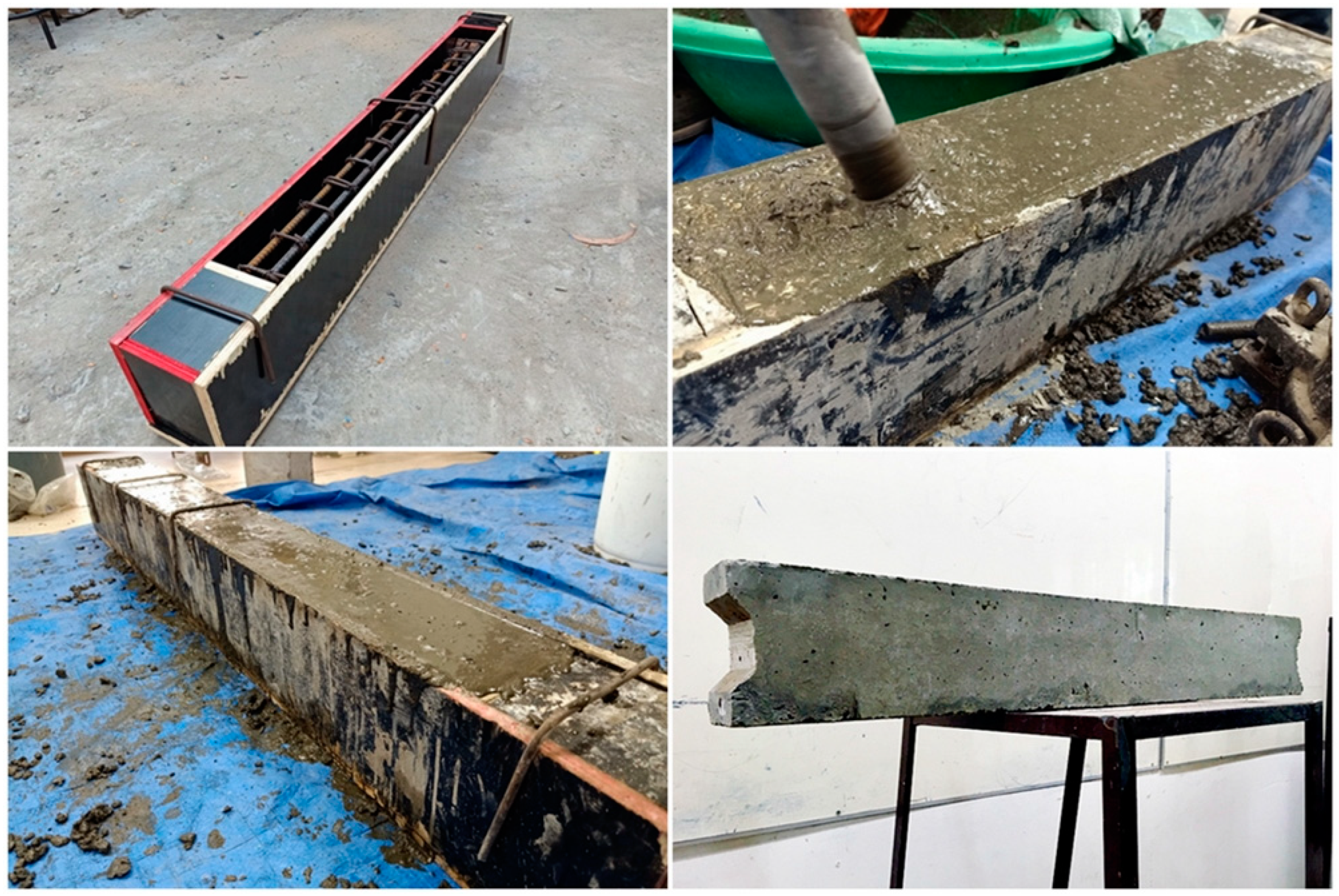
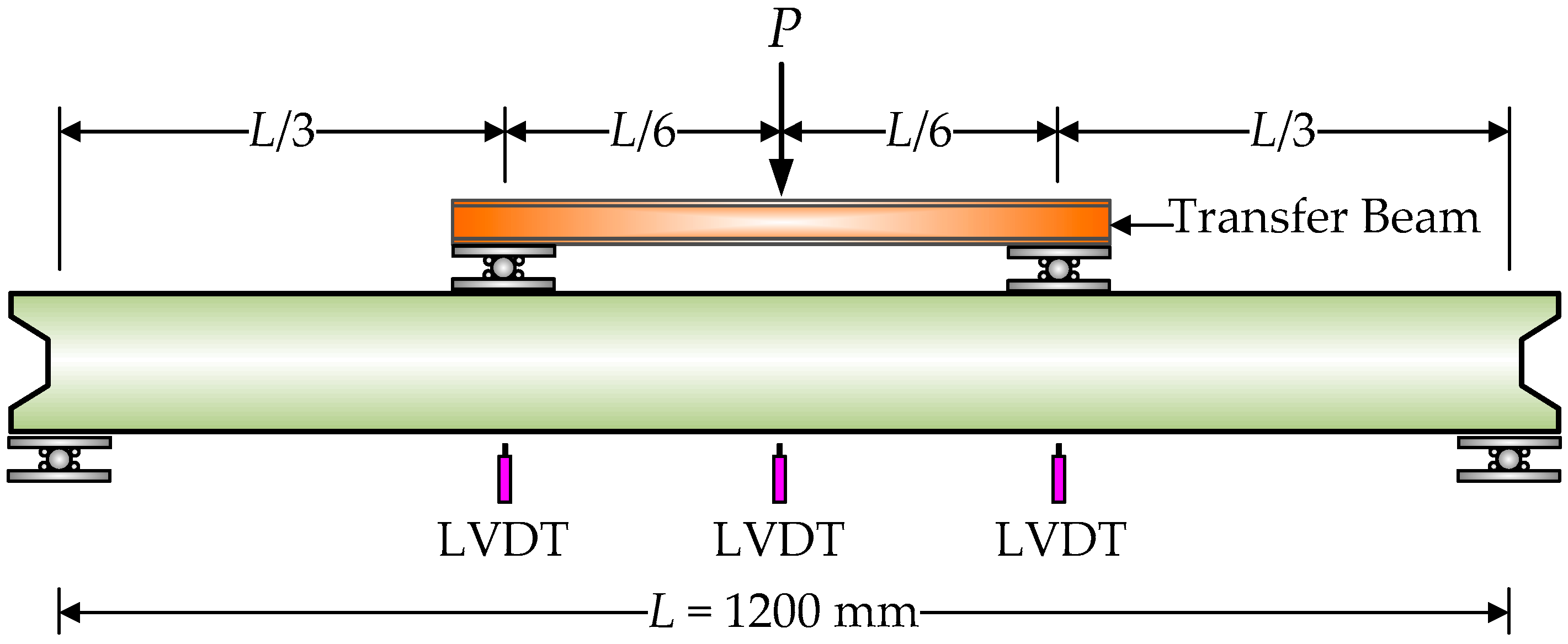



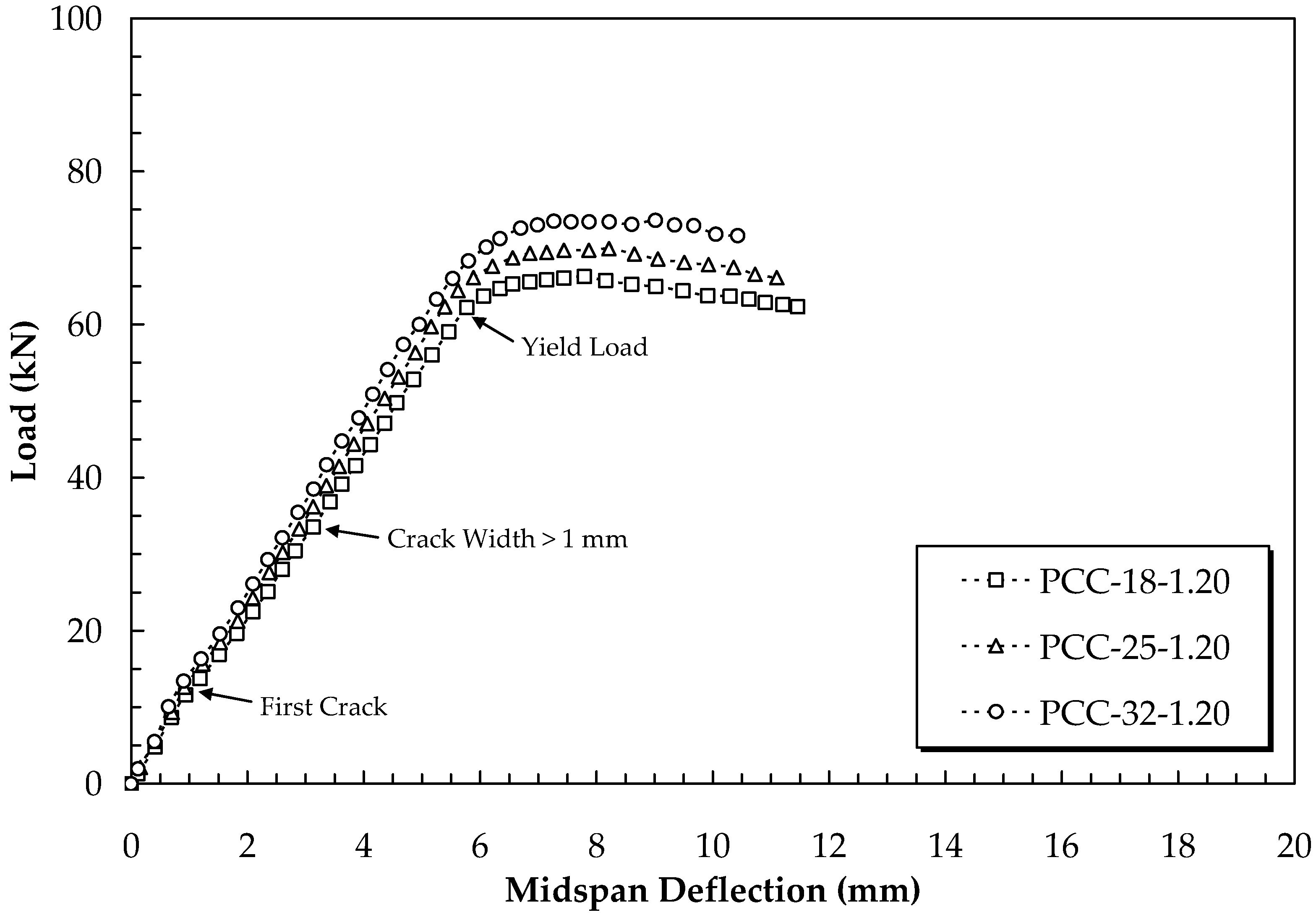
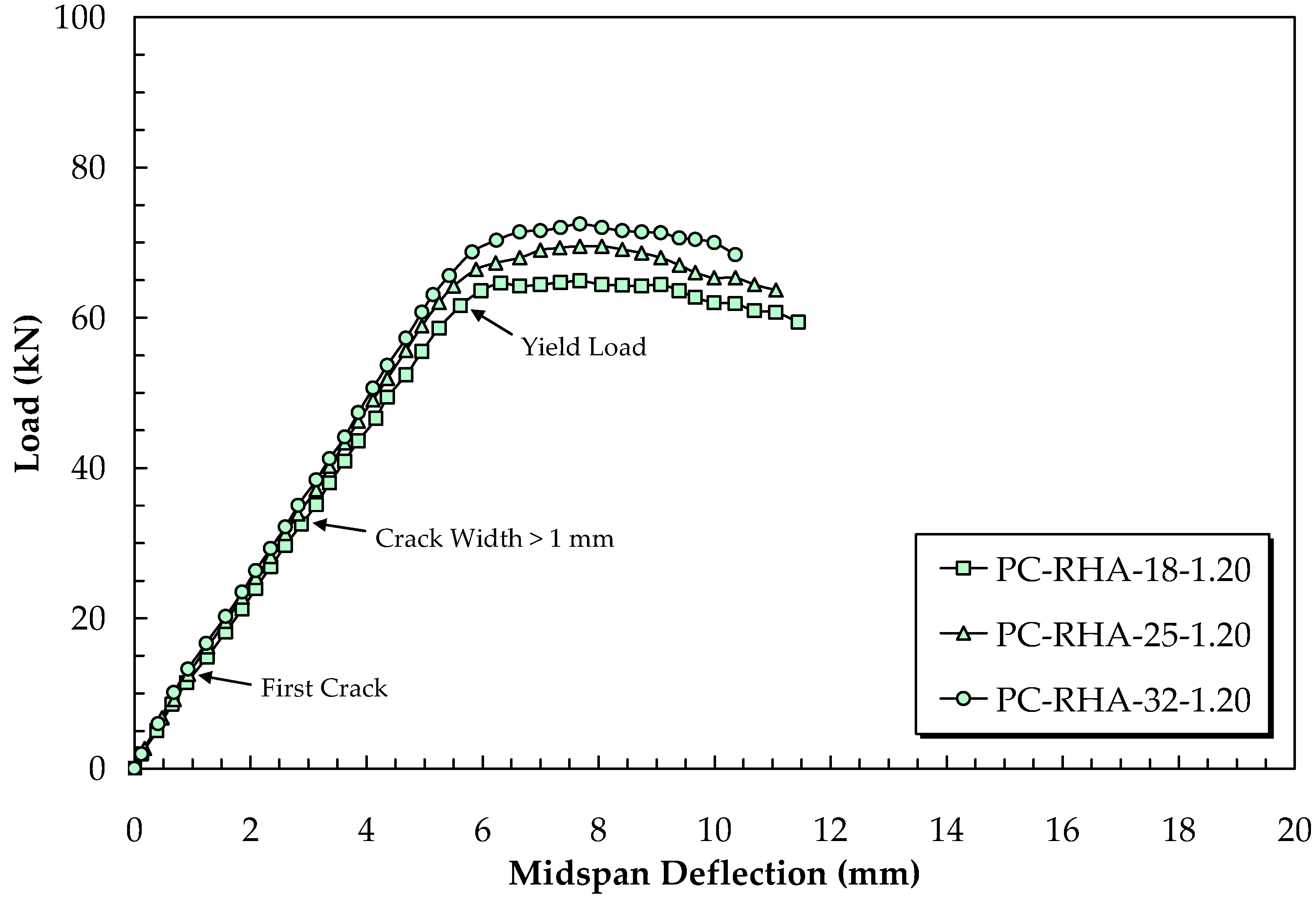
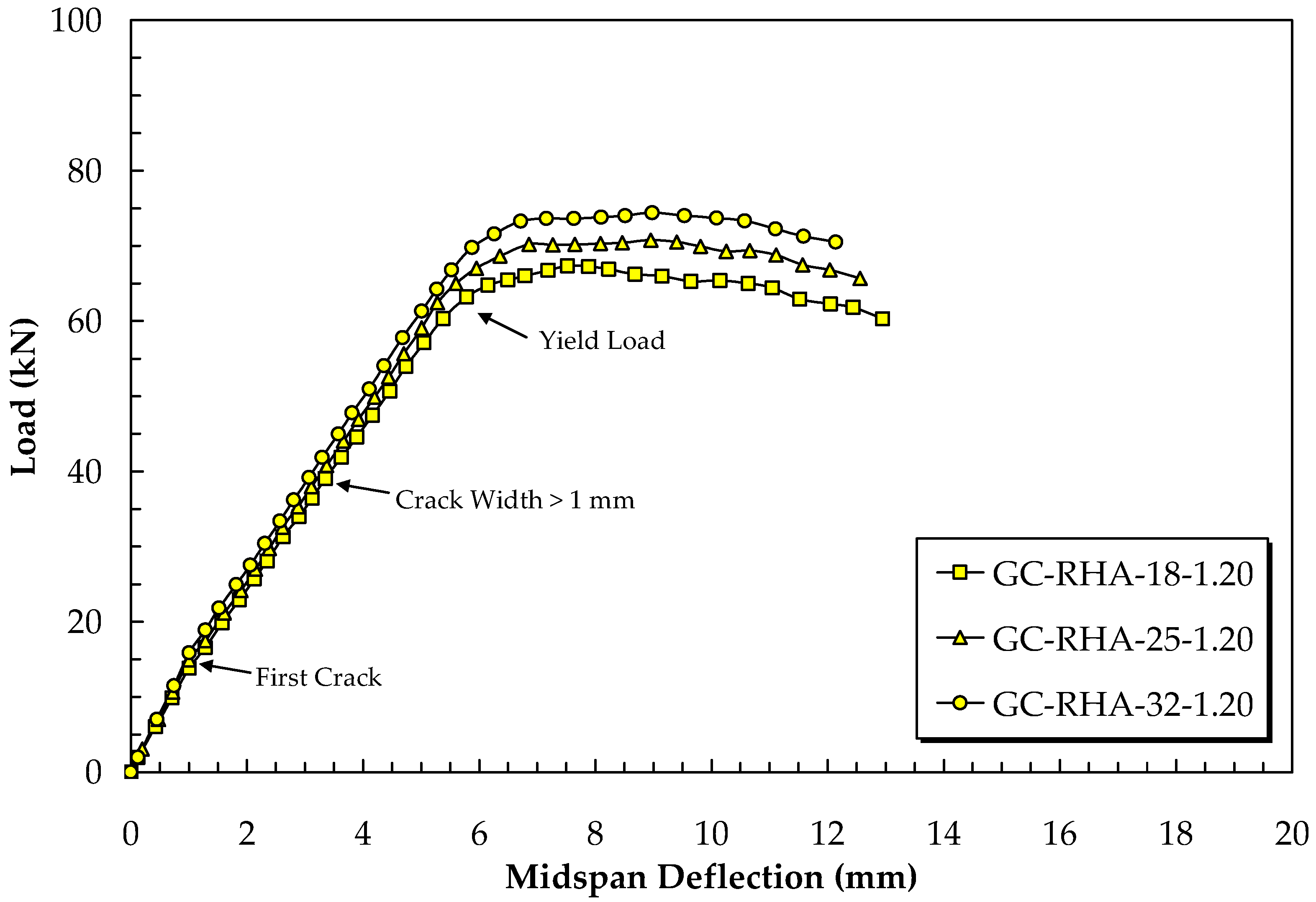


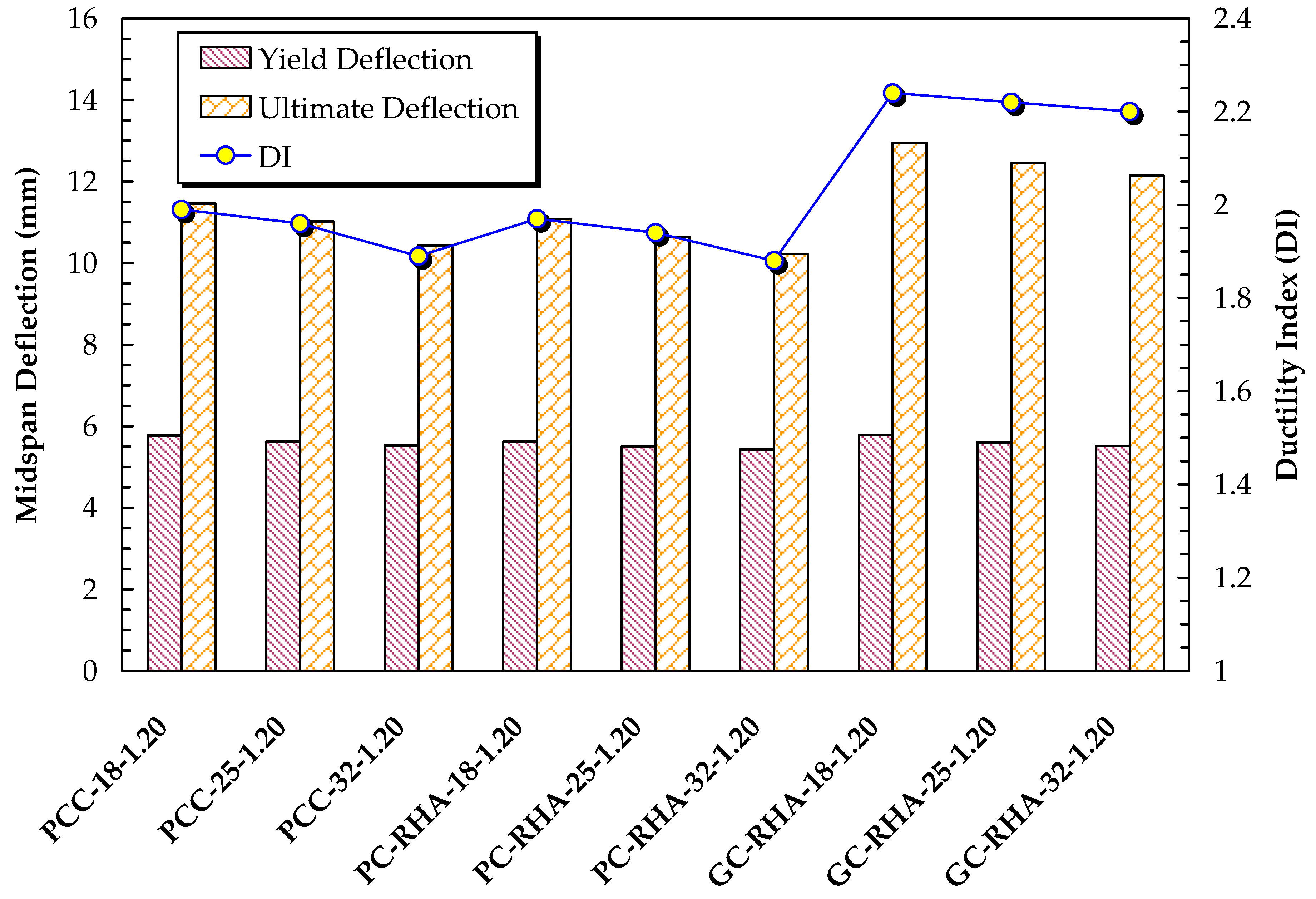
| Chemical Composition | PC (%) Present Study | RHA (%) | |||
|---|---|---|---|---|---|
| Present Study | [51] | [52] | [53] | ||
| SiO2 | 19.56 | 96.03 | 86.49 | 91.60 | 90.11 |
| Al2O3 | 4.80 | 0.01 | 0.01 | 0.09 | 1.19 |
| Fe2O3 | 3.14 | 0.13 | 0.91 | 0.64 | 0.85 |
| CaO | 64.69 | 0.53 | 0.50 | 1.38 | 0.89 |
| MgO | 1.37 | N.D. | 0.13 | N.D. | 0.90 |
| SO3 | 2.89 | 0.19 | N.D. | 0.21 | N.D. |
| Na2O | 0.15 | N.D. | 0.05 | N.D. | N.D. |
| K2O | 0.39 | 1.67 | 2.70 | 5.14 | 3.84 |
| LOI | 0.65 | 1.45 | 8.83 | 5.43 | 4.05 |
| Mix Proportions | Water (kg/m3) | PC (kg/m3) | CA (kg/m3) | FA (kg/m3) | SP (%) |
|---|---|---|---|---|---|
| PC-1-SP | 267.5 | 445.9 | 1337.6 | 891.7 | 1.0 |
| PC-2-SP | 248.4 | 382.2 | 1528.7 | 764.3 | 1.0 |
| PC-1 | 267.5 | 445.9 | 1337.6 | 891.7 | - |
| PC-2 | 248.4 | 382.2 | 1528.7 | 764.3 | - |
| PC-3 | 222.9 | 318.5 | 1433.1 | 796.2 | - |
| PC-4 | 215.0 | 286.6 | 1433.1 | 859.9 | - |
| Mix Proportions | RHA (%) | Water (kg/m3) | PC (kg/m3) | RHA (kg/m3) | CA (kg/m3) | FA (kg/m3) | SP (%) |
|---|---|---|---|---|---|---|---|
| PC-1-SP | 0 | 267.5 | 445.9 | 0 | 1337.6 | 891.7 | 1.0 |
| PC-RHA5-1-SP | 5 | 267.5 | 423.6 | 22.3 | 1337.6 | 891.7 | 1.0 |
| PC-RHA10-1-SP | 10 | 267.5 | 401.3 | 44.6 | 1337.6 | 891.7 | 1.0 |
| PC-RHA15-1-SP | 15 | 267.5 | 379.0 | 66.9 | 1337.6 | 891.7 | 1.0 |
| PC-RHA20-1-SP | 20 | 267.5 | 356.7 | 89.2 | 1337.6 | 891.7 | 1.0 |
| PC-RHA25-1-SP | 25 | 267.5 | 334.4 | 111.5 | 1337.6 | 891.7 | 1.0 |
| PC-RHA30-1-SP | 30 | 267.5 | 312.1 | 133.8 | 1337.6 | 891.7 | 1.0 |
| PC-2-SP | 0 | 248.4 | 382.2 | 0 | 1528.7 | 764.3 | 1.0 |
| PC-RHA5-2-SP | 5 | 248.4 | 363.1 | 19.1 | 1528.7 | 764.3 | 1.0 |
| PC-RHA10-2-SP | 10 | 248.4 | 344.0 | 38.2 | 1528.7 | 764.3 | 1.0 |
| PC-RHA15-2-SP | 15 | 248.4 | 324.8 | 57.3 | 1528.7 | 764.3 | 1.0 |
| PC-RHA20-2-SP | 20 | 248.4 | 305.7 | 76.4 | 1528.7 | 764.3 | 1.0 |
| PC-RHA25-2-SP | 25 | 248.4 | 286.6 | 95.5 | 1528.7 | 764.3 | 1.0 |
| PC-RHA30-2-SP | 30 | 248.4 | 267.5 | 114.6 | 1528.7 | 764.3 | 1.0 |
| PC-1 | 0 | 267.5 | 445.9 | 0 | 1337.6 | 891.7 | 0 |
| PC-RHA5-1 | 5 | 267.5 | 423.6 | 22.3 | 1337.6 | 891.7 | 0 |
| PC-RHA10-1 | 10 | 267.5 | 401.3 | 44.6 | 1337.6 | 891.7 | 0 |
| PC-RHA15-1 | 15 | 267.5 | 379.0 | 66.9 | 1337.6 | 891.7 | 0 |
| PC-RHA20-1 | 20 | 267.5 | 356.7 | 89.2 | 1337.6 | 891.7 | 0 |
| PC-RHA25-1 | 25 | 267.5 | 334.4 | 111.5 | 1337.6 | 891.7 | 0 |
| PC-RHA30-1 | 30 | 267.5 | 312.1 | 133.8 | 1337.6 | 891.7 | 0 |
| PC-2 | 0 | 248.4 | 382.2 | 0 | 1528.7 | 764.3 | 0 |
| PC-RHA5-2 | 5 | 248.4 | 363.1 | 19.1 | 1528.7 | 764.3 | 0 |
| PC-RHA10-2 | 10 | 248.4 | 344.0 | 38.2 | 1528.7 | 764.3 | 0 |
| PC-RHA15-2 | 15 | 248.4 | 324.8 | 57.3 | 1528.7 | 764.3 | 0 |
| PC-RHA20-2 | 20 | 248.4 | 305.7 | 76.4 | 1528.7 | 764.3 | 0 |
| PC-RHA25-2 | 25 | 248.4 | 286.6 | 95.5 | 1528.7 | 764.3 | 0 |
| PC-RHA30-2 | 30 | 248.4 | 267.5 | 114.6 | 1528.7 | 764.3 | 0 |
| Mix Proportions | RHA (%) | Na2SiO3 (kg/m3) | NaOH (kg/m3) | PC (kg/m3) | RHA (kg/m3) | CA (kg/m3) | FA (kg/m3) | SP (%) |
|---|---|---|---|---|---|---|---|---|
| GC-RHA5-1-SP | 5 | 374.5 | 160.5 | 423.6 | 22.3 | 1337.6 | 891.7 | 1.0 |
| GC-RHA10-1-SP | 10 | 374.5 | 160.5 | 401.3 | 44.6 | 1337.6 | 891.7 | 1.0 |
| GC-RHA15-1-SP | 15 | 374.5 | 160.5 | 379.0 | 66.9 | 1337.6 | 891.7 | 1.0 |
| GC-RHA20-1-SP | 20 | 374.5 | 160.5 | 356.7 | 89.2 | 1337.6 | 891.7 | 1.0 |
| GC-RHA25-1-SP | 25 | 374.5 | 160.5 | 334.4 | 111.5 | 1337.6 | 891.7 | 1.0 |
| GC-RHA30-1-SP | 30 | 374.5 | 160.5 | 312.1 | 133.8 | 1337.6 | 891.7 | 1.0 |
| GC-RHA5-2-SP | 5 | 321.0 | 137.6 | 363.1 | 19.1 | 1528.7 | 764.3 | 1.0 |
| GC-RHA10-2-SP | 10 | 321.0 | 137.6 | 344.0 | 38.2 | 1528.7 | 764.3 | 1.0 |
| GC-RHA15-2-SP | 15 | 321.0 | 137.6 | 324.8 | 57.3 | 1528.7 | 764.3 | 1.0 |
| GC-RHA20-2-SP | 20 | 321.0 | 137.6 | 305.7 | 76.4 | 1528.7 | 764.3 | 1.0 |
| GC-RHA25-2-SP | 25 | 321.0 | 137.6 | 286.6 | 95.5 | 1528.7 | 764.3 | 1.0 |
| GC-RHA30-2-SP | 30 | 321.0 | 137.6 | 267.5 | 114.6 | 1528.7 | 764.3 | 1.0 |
| GC-RHA5-1 | 5 | 374.5 | 160.5 | 423.6 | 22.3 | 1337.6 | 891.7 | 0 |
| GC-RHA10-1 | 10 | 374.5 | 160.5 | 401.3 | 44.6 | 1337.6 | 891.7 | 0 |
| GC-RHA15-1 | 15 | 374.5 | 160.5 | 379.0 | 66.9 | 1337.6 | 891.7 | 0 |
| GC-RHA20-1 | 20 | 374.5 | 160.5 | 356.7 | 89.2 | 1337.6 | 891.7 | 0 |
| GC-RHA25-1 | 25 | 374.5 | 160.5 | 334.4 | 111.5 | 1337.6 | 891.7 | 0 |
| GC-RHA30-1 | 30 | 374.5 | 160.5 | 312.1 | 133.8 | 1337.6 | 891.7 | 0 |
| GC-RHA5-2 | 5 | 321.0 | 137.6 | 363.1 | 19.1 | 1528.7 | 764.3 | 0 |
| GC-RHA10-2 | 10 | 321.0 | 137.6 | 344.0 | 38.2 | 1528.7 | 764.3 | 0 |
| GC-RHA15-2 | 15 | 321.0 | 137.6 | 324.8 | 57.3 | 1528.7 | 764.3 | 0 |
| GC-RHA20-2 | 20 | 321.0 | 137.6 | 305.7 | 76.4 | 1528.7 | 764.3 | 0 |
| GC-RHA25-2 | 25 | 321.0 | 137.6 | 286.6 | 95.5 | 1528.7 | 764.3 | 0 |
| GC-RHA30-2 | 30 | 321.0 | 137.6 | 267.5 | 114.6 | 1528.7 | 764.3 | 0 |
| Type | Specimen | Binder | Steel Rebar Properties | Number | ||
|---|---|---|---|---|---|---|
(MPa) | (MPa) | (GPa) | ||||
| PCC Beam (Control Beam) | PCC-18-1.20 | PC | 561.7 | 448.6 | 200.2 | 2 |
| PCC-25-1.20 | 561.7 | 448.6 | 200.2 | 2 | ||
| PCC-32-1.20 | 561.7 | 448.6 | 200.2 | 2 | ||
| PC-RHA Beam | PC-RHA-18-1.20 | PC-RHA | 561.7 | 448.6 | 200.2 | 2 |
| PC-RHA-25-1.20 | 561.7 | 448.6 | 200.2 | 2 | ||
| PC-RHA-32-1.20 | 561.7 | 448.6 | 200.2 | 2 | ||
| GC-RHA Beam | GC-RHA-18-1.20 | GC-RHA | 561.7 | 448.6 | 200.2 | 2 |
| GC-RHA-25-1.20 | 561.7 | 448.6 | 200.2 | 2 | ||
| GC-RHA-32-1.20 | 561.7 | 448.6 | 200.2 | 2 | ||
| Specimen | Concrete Properties | RC Beam | ||||||
|---|---|---|---|---|---|---|---|---|
| Binder | RHA (%) | (MPa) | (GPa) | (kN) | (kN) | (kN) | (mm) | |
| PCC-18-1.20 | PC | - | 19.3 | 20.7 | 11.6 | 62.3 | 66.2 | 3.6 |
| PCC-25-1.20 | - | 26.1 | 24.2 | 12.6 | 64.5 | 69.9 | 3.7 | |
| PCC-32-1.20 | - | 33.3 | 27.7 | 13.4 | 66.6 | 73.6 | 3.7 | |
| PC-RHA-18-1.20 | PC-RHA | 30 | 18.7 | 20.4 | 11.4 | 62.0 | 64.9 | 3.7 |
| PC-RHA-25-1.20 | 20 | 25.8 | 24.0 | 12.5 | 63.7 | 69.5 | 3.8 | |
| PC-RHA-32-1.20 | 10 | 32.8 | 27.4 | 13.2 | 65.8 | 72.5 | 3.9 | |
| GC-RHA-18-1.20 | GC-RHA | 30 | 20.5 | 21.4 | 13.8 | 63.5 | 67.3 | 3.1 |
| GC-RHA-25-1.20 | 20 | 26.3 | 24.5 | 15.0 | 65.4 | 70.8 | 3.0 | |
| GC-RHA-32-1.20 | 10 | 33.5 | 27.8 | 15.9 | 67.1 | 74.4 | 3.1 | |
| Type | Specimen | (kN) | (kN) | |
|---|---|---|---|---|
| PCC Beam (Control Beam) | PCC-18-1.20 | 62.3 | 59.8 | 1.04 |
| PCC-25-1.20 | 64.5 | 61.5 | 1.05 | |
| PCC-32-1.20 | 66.6 | 62.7 | 1.06 | |
| PC-RHA Beam | PC-RHA-18-1.20 | 62.0 | 59.6 | 1.04 |
| PC-RHA-25-1.20 | 63.7 | 61.4 | 1.04 | |
| PC-RHA-32-1.20 | 65.8 | 62.7 | 1.05 | |
| GC-RHA Beam | GC-RHA-18-1.20 | 63.5 | 60.1 | 1.06 |
| GC-RHA-25-1.20 | 65.4 | 61.6 | 1.06 | |
| GC-RHA-32-1.20 | 67.1 | 62.8 | 1.07 |
Publisher’s Note: MDPI stays neutral with regard to jurisdictional claims in published maps and institutional affiliations. |
© 2022 by the authors. Licensee MDPI, Basel, Switzerland. This article is an open access article distributed under the terms and conditions of the Creative Commons Attribution (CC BY) license (https://creativecommons.org/licenses/by/4.0/).
Share and Cite
Thumrongvut, J.; Seangatith, S.; Phetchuay, C.; Suksiripattanapong, C. Comparative Experimental Study of Sustainable Reinforced Portland Cement Concrete and Geopolymer Concrete Beams Using Rice Husk Ash. Sustainability 2022, 14, 9856. https://doi.org/10.3390/su14169856
Thumrongvut J, Seangatith S, Phetchuay C, Suksiripattanapong C. Comparative Experimental Study of Sustainable Reinforced Portland Cement Concrete and Geopolymer Concrete Beams Using Rice Husk Ash. Sustainability. 2022; 14(16):9856. https://doi.org/10.3390/su14169856
Chicago/Turabian StyleThumrongvut, Jaksada, Sittichai Seangatith, Chayakrit Phetchuay, and Cherdsak Suksiripattanapong. 2022. "Comparative Experimental Study of Sustainable Reinforced Portland Cement Concrete and Geopolymer Concrete Beams Using Rice Husk Ash" Sustainability 14, no. 16: 9856. https://doi.org/10.3390/su14169856






